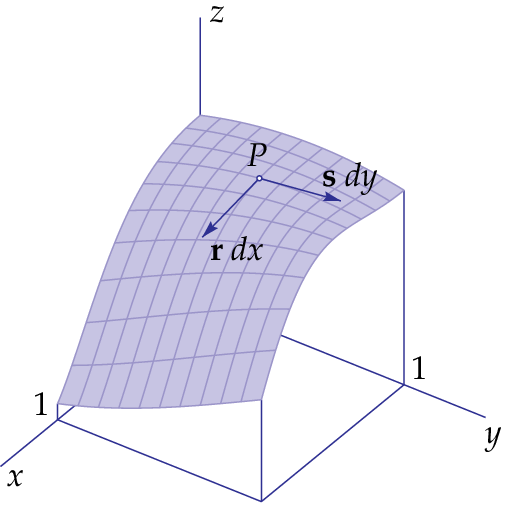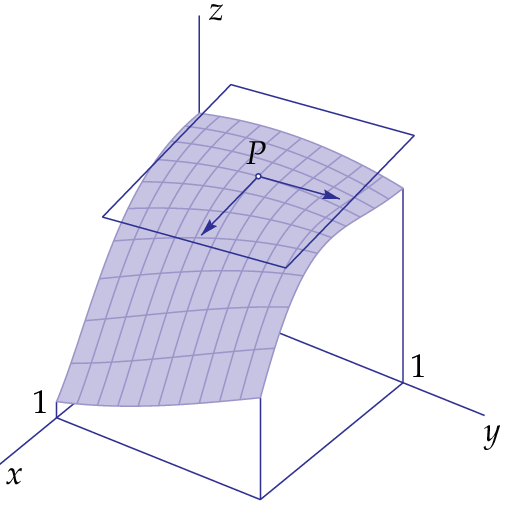Functions of several variables: Tangent vector and tangent plane
 Tangent vectors
Tangent vectors
In the figure below, tangent vectors at the point \(P=(a,b,c)\) with \(c=f(a,b)\) are drawn along the coordinate curves through that point: the point \(P\) is the initial point of both vectors. One tangent vector has a component in the \(x\) direction , which we name \(\dd x\), and a component in the \(y\) direction which is equal to zero. The component \(\dd z\) in the \(z\) direction is equal to \(f_x(a,b)\,\dd x\) because we have the function \(z=f(x,b)\) of one variable on the coordinate curve, and so we can specify the differential. The tangent vector starting at point \(P=(a,b)\) is \[\left(\begin{array}{c} \dd x \\ 0 \\ \dd z\end{array}\right)=\left(\begin{array}{c} \dd x \\ 0 \\ f_x(a,b)\,\dd x\end{array}\right)=\mathbf{r}\,\dd x\quad\text{with}\quad \mathbf{r}=\left(\begin{array}{c} 1 \\ 0 \\ f_x(a,b)\end{array}\right)\] The other tangent vector has a component in the \(y\) direction, which we name \(\dd y\), and a component in the \(x\) direction that is equal to zero. The component \(dz\) in the \(z\) direction is equal to \(f_y(a,b)\,\dd y\) because we have the function \(z=f(a,y)\) of one variable on the coordinate curve, and so we can specify the differential. If the graph of \(f(x,y)\) is a smooth surface near the point \(P=\bigl(a,b,f(a,b)\bigr)\), then the tangent vector starting at point \(P\) is \[\left(\begin{array}{c} 0 \\ \dd y \\ \dd z\end{array}\right)=\left(\begin{array}{c} 0 \\ \dd y \\ f_y(a,b)\,\dd y\end{array}\right)=\mathbf{s}\,\dd y\quad\text{with}\quad \mathbf{s}=\left(\begin{array}{c} 0 \\ 1 \\ f_y(a,b)\end{array}\right)\]

In the figure above, we have chosen components \(\dd x\) and \(\dd y\) of size \(0.4\), but you might as well make such a choice that the length of both tangent vectors is equal to one. The tangent vectors \(\mathbf{r}\) and \(\mathbf{s}\) span the tangent plane of the graph of \(f(x,y)\) at the point \(P\). Each vector with initial point \(P\) in the tangent plane is a linear combination \(\lambda\,\mathbf{r}+\mu\,\mathbf{s}\) of \(\mathbf{r}\) and \(\mathbf{s}\). Each of these vectors is a tangent vector at the point \(P\) on the surface plot of \(f(x,y)\). The following figure visualizes this.

For the vector representation of the tangent plane at point \(P\) we may use the vector with the origin as initial point and \(P\) terminal point as support vector.
Vector representation of a tangent plane Let \(f(x,y)\) be a function of two variables \(x\) and \(y\), and let the graph of \(f\) be a smooth surface near the point \(P=\bigl(a,b,f(a,b)\bigr)\). A vector representation of the tangent plane at \(P\) is \[\left(\begin{array}{c} x \\ y \\ z\end{array}\right)=\left(\begin{array}{c} a \\ b \\ f(a,b)\end{array}\right)+ \lambda\left(\begin{array}{c} 1 \\ 0 \\ f_x(a,b)\end{array}\right) + \mu\left(\begin{array}{c} 0 \\ 1 \\ f_y(a,b)\end{array}\right) \]


